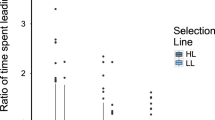Summary
The “badges of status” hypothesis suggests that frequency-dependent selection can maintain honest signalling of aggressiveness. Analysis of a simple ESS model reveals that this is only possible if aggressive individuals incur a cost independent of any particular fights they become involved in. Without such a cost, an honest population is vulnerable to invasion by a “modest” mutant bearing a dishonestly small badge. Analysis of a second model reveals that where individuals differ in their ability to bear the contest-independent cost of aggressiveness, badge size should reflect this ability. Under such circumstances, plumage badges which serve as honest status signals may have functional consequences beyond their role in settling contests. Thus females, when choosing a mate, could make good use of the information that plumage badges provide. Analysis of a third model shows that the existence of contest-independent benefits to badge size, such as increased mating success, is compatible with the maintenance of honest status signalling.
Similar content being viewed by others
References
Alexander J, Stimson WH (1988) Sex hormones and the course of parasitic infection. Parasitol Today 4:189–193
Dawkins R, Krebs JR (1978) Animal signals: information or manipulation? In: Krebs JR, Davies NB (eds) Behavioural ecology: an evolutionary approach. Blackwell Scientific, Oxford, pp 282–309
Eckert CG, Weatherhead PJ (1987) Ideal dominance distributions: a test using red-winged blackbirds (Agelaius phoeniceus). Behav Ecol Sociobiol 20:143–152
Evans M, Hatchwell B (1991) An experimental study of male adornment in the scarlet-tufted malachite sunbird: I the role of pectoral tufts in territory defence. Behav Ecol Sociobiol 29:413–420
Folstad I, Karter AJ (1992) Parasites, bright males and the immunocompetence handicap. Am Nat 139:603–622
Grossman CJ (1985) Interactions between the gonadal steroids and the immune system. Science 227:838–840
Hogstad O (1987) Is it expensive to be dominant? Auk 104:333–336
Jarvi T, Bakken M (1984) The function of variation of the breast stripe of the great tit (Parus major). Anim Behav 32:590–596
Jones IL (1990) Plumage variability functions for status signalling in least auklets. Anim Behav 39:967–975
Maynard Smith J (1974) The theory of games and the evolution of animal conflicts. J Theor Biol 47:209–221
Maynard Smith J (1982) Evolution and the theory of games. Cambridge University Press, Cambridge
Maynard Smith J, Harper DGC (1988). The evolution of aggression: can selection generate variability? Phil Trans R Soc London B319:557–570
Møller AP (1987) Variation in badge size in male house sparrows Passer domesticus: evidence for status signalling. Anim Behav 37:1637–1644
Møller AP (1988) Badge size in the sparrow Passer domesticus: effects of intra- and inter-sexual selection. Behav Ecol Sociobiol 22:373–378
Norris KJ (1990) The evolution of the conspicuous plumage colouration of monogamous male great tits. Behav Ecol Sociobiol 26:129–138
Owens IPF, Hartley IR (1991) ‘Trojan sparrows’: Evolutionary consequences of dishonest invasion for the badges-of-status model. Am Nat 138:1187–1205
Rohwer SA (1975) The social significance of avian plumage variability. Evolution 29:593–610
Røskaft E, Rohwer S (1987) An experimental study of the function of the epaulets and the black body colour of male red-winged blackbirds. Anim Behav 35:1070–1077.
Røskaft E et al. (1986) The relationship between social status and resting metabolic rate in great tits (Parus major) and pied flycatchers (Ficedula hypoleuca). Anim Behav 34:838–842
Studd MV, Robertson RJ (1985) Evidence for reliable badges of status in yellow warblers (Dendroica petechia). Anim Behav 33:1102–1113
Wedekind C (1992) Detailed information about parasites revealed by sexual ornamentation. Proc R Soc London Ser B 247:169–174
Zuk M (1990) Reproductive strategies and disease susceptibility: an evolutionary viewpoint. Parasitol Today 6:231–233
Author information
Authors and Affiliations
Additional information
Correspondence to: R.A. Johnstone
Rights and permissions
About this article
Cite this article
Johnstone, R.A., Norris, K. Badges of status and the cost of aggression. Behav Ecol Sociobiol 32, 127–134 (1993). https://doi.org/10.1007/BF00164045
Received:
Accepted:
Issue Date:
DOI: https://doi.org/10.1007/BF00164045




